#Jamestown 91
Explore tagged Tumblr posts
Text
Happy International Day of Human Space Flight from my favorite fictional astronaut. 👨🚀🚀🌕



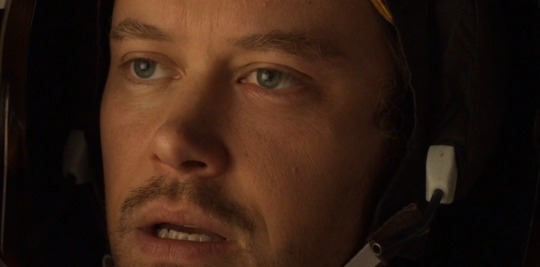
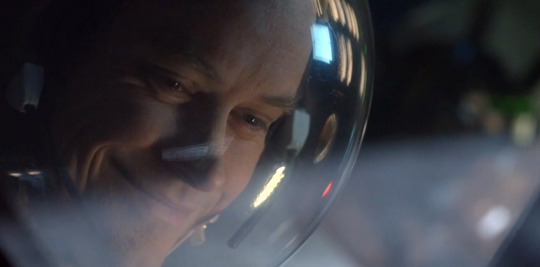



#for all mankind#gordo stevens#michael dorman#international day of human space flight#astronaut#outer space#space#moon#jamestown 91#nasa#space exploration
24 notes
·
View notes
Text


Donna Lorraine Hammond Allen, BJU Class of 1956, and Walter Allen, BJU Class of 1957.
Together in Life and Death
Donna Lorraine Allen, 91, passed away on November 14, 2024, at 2:30 am. She was born on October 21, 1933, to Ruth and Forrest Hammond. She grew up in the Jamestown, New York, area and graduated from Bob Jones University in 1956. She taught in many schools in Ohio during her long career–and encountered many of her former students as adults. Along with her parents, Donna was preceded in death by her older brother, Bob Hammond, and her older sister, June Zimmerman. She and her loving husband, Walter Allen, passed away within 17 hours of each other on the same day after 68 years of marriage.
Walter Dale Allen, 91, passed away on November 14, 2024, at 9 pm. He was born on November 9, 1933, to Nina and Dale Allen. He was born and grew up in Morgan County, Ohio. He was trained as a minister and teacher and graduated in 1957 from Bob Jones University. He taught for two years in Atka, Alaska (near Russia) and two additional years in Deering, Alaska (near the arctic circle), and then began teaching in Ohio for many additional years. He also worked in his later years in the scrap-metal business. He was preceded in death by his parents and two brothers, Dave Allen and Chester Francis.
Both Walter and Donna Allen were devout Christians, and their faith helped them through the ups and downs of their lengthy life courses. They both taught a number of Sunday school classes over the years that gave them great joy.
Walter and Donna Allen are survived by their three sons: Roger (wife Diane), Philip (wife Lisa), and Stephen (wife Dawn) Allen. They were also proud grandparents to Sasha, Jerold, Robby, Jerel, Anthony, Aaron, Lauren, Hanna, Benjamin, Nathan, and Natalie (and three great-grandchildren–Elijah, Emily, and Dominic).
A memorial service will be held at 2 PM on Saturday, December 7, 2024, at McCurdy Funeral Home, 309 6th St, Beverly, Ohio 45715. Visitation for family and friends will be from 1 PM until the time of the service. Online condolences may be made by visiting www.mccurdyfh.com.
#Bob Jones University#BJU Alumni Association#Obituary#BJU Hall of Fame#Donna Hammond Allen#Class of 1956#Walter Allen#Class of 1957
1 note
·
View note
Text
Jamestown: 92 bottles of milk on the wall 92 bottles of milk you take one down, pass it around 91 bottles of milk on the wall
NYC: 99 bottles of milk on the wall 99 bottles of milk yeah take one down pass it around 98 bottles of milk on the wall
25 notes
·
View notes
Text
SORROWFUL JONES
JULY 4, 1949

Sorrowful Jones is a remake of the 1934 Shirley Temple film, Little Miss Marker. In the film, a young girl is left with the notoriously cheap Sorrowful Jones (Bob Hope) as a marker for a bet. When her father does not return, he learns that taking care of a child interferes with his free-wheeling lifestyle. Lucille Ball plays a nightclub singer who is dating Sorrowful's boss.
Although the official opening night in Hollywood took place on Independence Day 1949, it was premiered in New York City a month earlier, and seen in Australia on June 24, 1949.
Directed by Sidney Lanfield Produced by Robert L. Welch Written by Edmund Hartmann and Melville Shavelson based on a story by Damon Runyon
CREDITED CAST

Lucille Ball (Gladys) was born on August 6, 1911 in Jamestown, New York. She began her screen career in 1933 and was known in Hollywood as ‘Queen of the B’s’ due to her many appearances in ‘B’ movies. With Richard Denning, she starred in a radio program titled “My Favorite Husband” which eventually led to the creation of “I Love Lucy,” a television situation comedy in which she co-starred with her real-life husband, Latin bandleader Desi Arnaz. The program was phenomenally successful, allowing the couple to purchase what was once RKO Studios, re-naming it Desilu. When the show ended in 1960 (in an hour-long format known as “The Lucy-Desi Comedy Hour”) so did Lucy and Desi’s marriage. In 1962, hoping to keep Desilu financially solvent, Lucy returned to the sitcom format with “The Lucy Show,” which lasted six seasons. She followed that with a similar sitcom “Here’s Lucy” co-starring with her real-life children, Lucie and Desi Jr., as well as Gale Gordon, who had joined the cast of “The Lucy Show” during season two. Before her death in April 1989, Lucy made one more attempt at a sitcom with “Life With Lucy,” also with Gordon, which was not a success and was canceled after just 13 episodes. She died on April 26, 1989 at the age of 77.
Ball's singing voice is provided by Annette Warren, who also sang for her in Fancy Pants and later provided the singing voice for Ava Gardner in Show Boat. Her first screen dubbing was for Lured featuring Lucille Ball, although Warren did not dub Lucy’s voice. She provided the singing voice for Pepper (Iris Adrian) in the Bob Hope film The Paleface (1947).
Bob Hope (Sorrowful Jones) was born Lesley Townes Hope in England in 1903. During his extensive career in virtually all forms of media he received five honorary Academy Awards. In 1945, Desi Arnaz was the orchestra leader on Bob Hope’s radio show. Ball and Hope did three other films together. He appeared as himself on the season 6 opener of “I Love Lucy.” He did a brief cameo in a 1964 episode of “The Lucy Show.” He died in 2003 at age 100.
Mary Jane Saunders (Martha Jane) makes her film debut. She went on to do a season of TV’s “Tales of the Welles Fargo” (1960-61) and made two appearances on “My Three Sons”: one with William Frawley and one with William Demarest.
William Demarest (Regret) is best remembered as Uncle Charlie on “My Three Sons,” a role created after the death of William Frawley. Demarest and Frawley appeared together on screen in The Farmer’s Daughter (1940). He was nominated for an Academy Award in the biography, The Jolson Story (1946). Demarest did two other films with Lucille Ball: Fugitive Lady (1934) and Don’t Tell The Wife (1937). He died in 1983 at age 91.
Bruce Cabot (Big Steve) appeared with Lucille Ball in 1934′s Men of the Night. In 1950, he joined Hope and Ball once again in Fancy Pants. His main claim to fame is rescuing Fay Wray from King Kong (1933).
Tom Pedi (Once Over Sam) did one season of the short-lived sitcom “Arnie” (1970-71). He was in the 1980 remake of Little Miss Marker, upon which Sorrowful Jones is based.
Paul Lees (Orville Smith) was blinded by enemy artillery during his service in World War II. He received 32 military decorations and ribbons, including the Legion of Merit. Despite his lack of vision, Lees learned to act and signed a contract with Paramount. He would memorize script dialog by having someone read it to him twice.
Houseley Stevenson (Doc Chesley) was a British-born character actor who had just finished doing The Paleface with Bob Hope.
Ben Weldon (Big Steve’s Bodyguard) appeared on “I Love Lucy” as the thief who breaks in to the Ricardo apartment to steal “The Fur Coat” (ILL S1;E9). He was seen in a season one episode of “The Lucy Show.”
Emmett Vogan (Psychiatrist) did four movies with Lucille Ball previous to this one. In 1954 he played Mr. Bolton in The Long, Long Trailer.
Thomas Gomez (Reardon) was an Oscar nominee for Ride the Pink Horse the previous year. In 1953 he was seen as Pasquale #2 on CBS’s “Life With Luigi”. He did a 1964 episode of “My Three Sons” with William Demarest.
UNCREDITED CAST (with connections to Lucille Ball)
Ethel Bryant (Nurse) was also seen with Lucille Ball in Broadway Bill (1934), another film involving a racehorse. John Butler (Jack - Bettor on Green Diamond) was also seen with Lucille Ball in The Affairs of Annabel (1938).
Bill Cartledge (First Jockey) was also seen with Lucille Ball in The Joy of Living (1938).
Maurice Cass (Psychiatrist) was also seen with Lucille Ball (and John Butler) in The Affairs of Annabel (1938).
Michael Cirillo (Horse Player) joined Bob Hope in Paleface and Son of Paleface as well as Critic’s Choice with Hope and Ball in 1963.
Charles Cooley (Shorty) was seen with Hope and Ball in Fancy Pants (1950) as well as a dozen other Bob Hope films. He also was a regular on “The Bob Hope Show” on television.
James Dearing (Spectator) was in eight other Lucille Ball films between 1936 and 1954.
Jay Eaton (Horse Player) was in eight other Lucille Ball films between 1937 and 1946.
Chuck Hamilton (Police Officer) was seen in the background of eight other Lucille Ball films from 1937 to 1950.
Selmer Jackson (Doctor) was in six other Lucille Ball films between 1933 and 1949.
Kenner G. Kemp (Bookmaker) was in seven other Lucille Ball films between 1936 and 1960 as well as doing background work on a 1965 episode of “The Lucy Show.”
Bob Kortman (Horse Player) was in four other Lucille Ball films between 1934 and 1950.
George Magrill (Horse Player) makes the last of his nine film appearances with Lucille Ball. He started in 1933 with Broadway Thru A Keyhole.
John Mallon (Horse Player) was also seen with Hope and Ball in Fancy Pants (1950).
John ‘Skins’ Miller (Jockey) was also seen with Hope and Ball in Fancy Pants (1950) and previously with Ball in The Big Street (1942).
Frank Mills (Horse Player) makes the last of his ten film appearances with Lucille Ball. He started in 1933 with The Bowery.
Ralph Montgomery (Horse Player) was one of the policeman on the scene in “Lucy Goes To The Hospital” (ILL S2;E16) in 1953.
Ralph Peters (Taxi Driver) was also seen with Lucille Ball in The Big Street (1942).
Suzanne Ridgeway (Nightclub Patron) was also seen with Lucille Ball in That’s Right - You’re Wrong (1939) and The Magic Carpet (1951).
Arthur Space (Plainclothes Policeman) was in four other films with Lucille Ball between 1945 and 1950.
Bert Stevens (Nightclub Patron) was a background player in four Lucille Ball films as well as one episode of “I Love Lucy,” and many of “The Lucy Show.”
Sid Tomack (Waiter at Steve’s Place) was also seen in The Fuller Brush Girl (1950) with Lucille Ball.
Harry Tyler (Blinky) did three other films with Lucille Ball between 1937 and 1950.
Walter Winchell (Himself, Voice Over) was a journalist and radio host who was the narrator of Desilu’s “The Untouchables.” He also joined the cast in their satire of the series on “Lucy The Gun Moll” (TLS S4;E25).

The film was made at Paramount Studios in Hollywood, with location shooting in New York City. This was Lucille Ball’s 70th film!

The New York Times, August 16, 1947. Note that Lucille Ball is not mentioned. (Thanks to @ericthelibrarian for the scan)
THE STORY

Sorrowful Jones (Bob Hope) is a New York bookie who keeps his operation hidden behind a trap door in a Broadway barber shop. He suffers a financial setback when a horse named Dreamy Joe, owned by gangster Big Steve Holloway (Bruce Cabot), unexpectedly wins a race and Jones has to pay all the bettors.
Jones learns that the race was fixed by Big Steve, who tells him about giving the horse a "speedball." It turns out Big Steve has informed all the bookies in his circle of friends about the fixed race, and demands a sum of $1,000 from each one of them in exchange for this information.
Before the next race, Jones learns Dreamy Joe will lose, but still takes bets on the horse from his customers. He even takes a bet from gambler Orville Smith (Paul Lees), who leaves his four-year-old daughter Martha Jane (Mary Jane Saunders) as collateral. Orville overhears a phone call where Big Steve reveals that the race is fixed, so he is killed by one of Big Steve's goons, Once Over Sam (Tom Pedi). Jones is forced to take care of Martha Jane and brings her home with him.
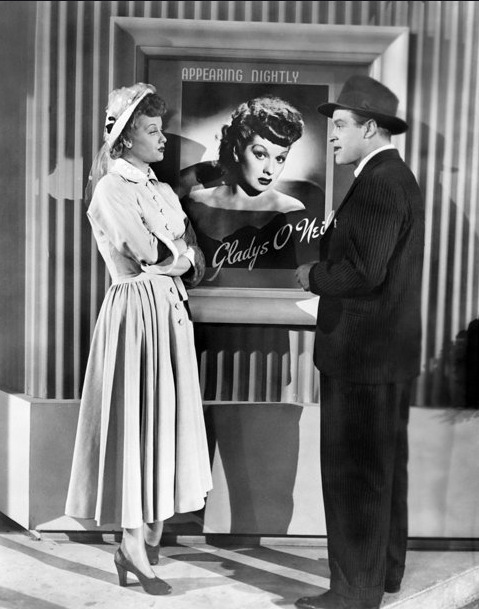
The next day Jones gets help from his ex-girlfriend, burlesque performer Gladys O'Neill (Lucille Ball).
Big Steve tells Jones he is being investigated by the racing commission so he is quitting the race-fixing business. Big Steve plans to make one final race before he gets out of the game, where he is fixing it so that Dreamy Joe will win. He also transfers the ownership of the horse to Martha Jane, unaware that she is Orville's daughter. After the race, Big Steve will kill the horse by giving it a high dose of "speedball."

Jones tries to find Martha Jane's mother, but discovers she is dead. Gladys suggests that Jones give all of Dreamy Joe's winnings to Martha Jane to help her survive, or she will contact the police and tell them about Jones' operation. She has no knowledge of Big Steve's plan to fix the race.

Big Steve finds out that Martha Jane is Orville's daughter, so Jones must hide her to protect her from being killed. When hiding on a fire escape's landing, Martha Jane falls down and is seriously injured. In a coma, the little girl calls out for Dreamy Joe.
In order to save Martha Jane and wake her up, Jones and his partner Regret (William Demarest) steal the horse from Big Steve at the race track. They take it into the hospital room where Martha Jane lies. Martha Jane wakes up and the police find out that Big Steve is responsible for Orville's murder.
After Big Steve is arrested, Jones proposes to Gladys. The police want Martha Jane to be placed in an orphanage, but Jones and Gladys, who have married, decide to adopt the girl. They go away on their honeymoon together with their newly adopted daughter.
TRIVIA & BACKGROUND

“Little Miss Marker” (1932), a short story by Damon Runyon, inspired the film Sorrowful Jones.

Damon Runyon’s 1940 short story “Little Pinks” served as the basis for the Lucille Ball / Henry Fonda film The Big Street (1942).

Little Miss Marker (1934) starring Adolphe Menjou as Sorrowful Jones and Dorothy Dell as Bangles Carson. Shirley Temple as Marthy Jane. The film was directed by Alexander Hall, Lucille Ball’s one-time fiance.
Sorrowful Jones (1947) starring Bob Hope as Sorrowful Jones and Lucille Ball as Gladys O’Neill. Mary Jane Saunders as Martha Jane.
40 Pounds of Trouble (1962) starring Tony Curtis as Steve McCluskey and Suzanne Pleshette as Chris Lockwood. Claire Wilcox as Penelope Piper.
Little Miss Marker (1980) starring Walter Matthau as Sorrowful Jones and Julie Andrews as Amanda Worthington. Sarah Stimson as the Kid.
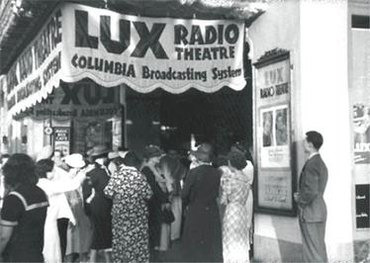
"Lux Radio Theater" broadcast a 60 minute radio adaptation of the movie on November 21, 1949 with Bob Hope and Lucille Ball reprising their film roles.

“Havin' a Wonderful Wish (Time You Were Here)” by Jay Livingston with lyrics by Ray Evans is sung by Lucille Ball (dubbed by Annette Warren).

“Miss Beverley Hills of Hollywood” comic book issue #6, January / February 1947 promoted the film. Lucille Ball still is purporting to have been born in Butte, Montana. Here her birth date is also incorrect: August 6, not August 8. Note how much the Drama Teacher resembles Lucy’s mother, Dede Ball.
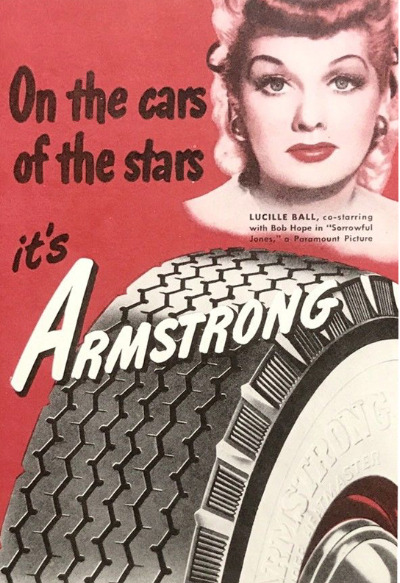
Lucille Ball advertising both Armstrong Tires and Sorrowful Jones.

Lucille Ball advertising Sealright Sanitary Containers using Sorrowful Jones.

In “The Bob Hope Christmas Special” (1973) Lucy opens a small wooden box and removes a lock of Hope’s hair she says she snipped from his head when they were making Sorrowful Jones together.

The film was mentioned when Lucille Ball and Bob Hope guested on “Dinah!” in 1977.

In 1989, after Ball’s passing, a clip from the film was incorporated into “Bob Hope’s Love Affair With Lucy.”
#Lucille Ball#Sorrowful Jones#Little Miss Marker#Bob Hope#Mary Jane Saunders#William Demarest#Damon Runyon#Walter Winchell#Bruce Cabot#Thomas Gomez#1949#Paramount Pictures#Annette Warren#Sidney Landfield#movies#Hollywood#Lucy
4 notes
·
View notes
Text
SUPERGIRL PLAYLIST: SEASON 1 (PART I)
Summary: This is a compilation of songs that can possibly summarize Kara and James’s thoughts and feelings throughout Season 1 of Supergirl. All of these songs were compiled using the application Spotify Song Radio and the song “Sedona” by Houndmouth in Episode 3 of Season 1 of Supergirl as its base.
1. Sedona - Houndmouth
2. I Wanna Get Better - Bleachers
3. Angela - Lumineers
4. Run Right Back - Moon Taxi
5. Rivers and Roads - The Head and the Heart
6. She Lit a Fire - Lord Huron
7. Flowers in Your Hair - The Lumineers
8. Bloom (Bonus Track) - The Paper Kites
9. Take It All Back 2.0 - Judah & the Lion
10. All the Debts I Owe - Caamp
11. Bob Marley - Grizfolk
12. You Go Down Smooth - Lake Street Dive
13. Hallucinogenics - Matt Maeson
14. June, After Dark - Elliot Root
15. Dearly Departed (feat. Esme Patterson)
16. You Are the Best Thing - Ray LaMontagne
17. Another Story - The Head and the Heart
18. All Your Favorite Bands - Dawes
19. Missed the Boat - Modest Mouse
20. Silhouettes - Colony House
21. I And Love And You - The Avett Brothers
22. Home (2019 Remaster) - Edward Sharpe & The Magnetic Zeros
23. This Must Be The Place - Iron & Wine, Ben Birdwell
24. Sweet Pea - Amos Lee
25. Old Friends - Pinegrove
26. Don’t Take The Money - Bleachers
27. Truly Madly Deeply (Recorded at Spotify Singles) - Yoke Lore
28. Don’t Dream It’s Over - The Head and the Heart
29. Comeback Kid (That’s My Dog) - Brett Dennen
30. Darlin’ - Houndmouth
31. Gone - JR JR
32. Ophelia - The Lumineers
33. Big Black Car - Gregory Alan Isakov
34. Kickin’ da Leaves - Judah & the Lion
35. On the Road - Houndmouth
36. All Day All Night - Moon Taxi
37. Cold Cold Man - Saint Motel
38. Two of Us On the Run - Lucius
39. Where The Skies Are Blue - The Lumineers
40. Honeybee - The Head and the Heart
41. California (Cast Iron Soul) - Jamestown Revival
42. Amerika - Young the Giant
43. Lost/ Inside Our Minds - John Vincent III
44. Things Happen - Dawes
45. Sleep On The Floor - The Lumineers
46. Changes - Langhorne Slim & The Law
47. Into The Deep (feat. Macy Gray) - Galactic & Macy Gray
48. Suit and Jacket - Judah & the Lion
49. Complainer - Cold War Kids
50. All We Ever Knew - The Head and the Heart
51. Wait by the River - Lord Huron
52. No Hard Feelings - Avett Brothers
53. When U Love Somebody - Fruit Bats
54. San Francisco - The Mowgli’s
55. Reflections - MisterWives
56. Miracle Mile - Cold War Kids
57. Ain’t No Man - The Avett Brothers
58. Hands Down - The Greeting Committee
59. Comeback Kid – Brett Dennen
60. June, After Dark - Elliot Root
61. When the Night is Over - Lord Huron
62. Nellie - The Dog
63. Buttercup - Hippo Campus
64. We Don’t Know - The Strumbellas
65. The Underdog - Spoon
66. Cassidy – Brett Dennen
67. Honeybody - Kishi Bashi
68. Cocaine Jesus - Rainbow Kitten Surprise
69. Shake - The Head and the Heart
70. Beyond - Leon Bridges
71. Empress - Morningsiders
72. Good Kisser - Lake Street Dive
73. Rivers and Roads - The Head and the Heart
74. Same Drugs - MisterWives
75. Olivia - Rayland Baxter
76. Stronger Than That - Bahamas
77. Comin’ Round Again - Houndmouth
78. Better Than - Lake Street Dive
79. Limestone - Magic City Hippies
80. Lake Michigan - Rogue Wave
81. Lost In My Mind - The Head and the Heart
82. Cringe - Matt Maeson
83. The Stable Song - Gregory Alan Isakov
84. Blue Hole Bridge - Boy Named Banjo
85. Beige - Yoke Lore
86. Hello My Old Heart - Oh Hello
87. First - Cold War Kids
88. My Cousin Greg - Houndmouth
89. All That and More (Sailboat) - Rainbow Kitten Surprise
90. Something To Believe In - Young the Giant
91. I Wish I Was - Avett Brothers
92. Welcome To Your Life - Grouplove
93. Take It All Back 2.0 - Judah & the Lion
94. Down In The Valley - The Head and the Heart
95. Buttons - The Weeks
96. Punks and Poets - Elliot Root
97. Superposition - Young the Giant
98. South - Hippo Campus
99. Heavy - Birdtalker
100. Silvertongue - Young the Giant
3 notes
·
View notes
Text
Gwen Ifill









Gwendolyn L. (Gwen) Ifill (/ˈaɪfəl/; September 29, 1955 – November 14, 2016) was an American journalist, television newscaster, and author. She was the moderator and managing editor of Washington Week and co-anchor and co-managing editor, with Judy Woodruff, of PBS NewsHour, both of which air on PBS. Ifill was a political analyst and moderated the 2004 and 2008 Vice Presidential debates. She was the author of the book The Breakthrough: Politics and Race in the Age of Obama.
Early life and education
Ifill was born in New York City, the fifth child of African Methodist Episcopal (AME) minister (Oliver) Urcille Ifill, Sr., a Panamanian of Barbadian descent who emigrated from Panama, and Eleanor Ifill, who was from Barbados. Her father's ministry required the family to live in several cities throughout New England and the Eastern Seaboard during her youth. In her childhood, Ifill lived in Pennsylvania and Massachusetts church parsonages and in federally subsidized housing in Buffalo and New York City. She graduated in 1977 with a Bachelor of Arts in Communications from Simmons College in Boston, Massachusetts.
Career
While at Simmons College, Ifill interned for the Boston Herald-American and was hired after graduation by editors deeply embarrassed by an incident during her internship in which a coworker wrote her a note that read, "Nigger go home." Later she worked for the Baltimore Evening Sun (1981–84), The Washington Post (1984–91), The New York Times (1991–94), and NBC.
In October 1999, she became the moderator of the PBS program Washington Week in Review. She is also senior correspondent for the PBS NewsHour. Ifill has appeared on various news shows, including Meet the Press.
She serves on the board of the Harvard Institute of Politics, the Committee to Protect Journalists, the Museum of Television and Radio, and the University of Maryland's Philip Merrill College of Journalism.
On February 7, 2011, Ifill was made an Honorary Member of Delta Sigma Theta during the sorority's 22nd Annual Delta Days in the Nation’s Capital.
With Kaitlyn Adkins, Ifill co-hosted Jamestown LIVE!, a 2007 History Channel special commemorating the 400th anniversary of Jamestown, Virginia.
The PBS ombudsman, Michael Getler, has twice written about the letters he's received complaining of bias in Ifill's news coverage. He dismissed complaints that Ifill appeared insufficiently enthusiastic about Sarah Palin's speech at the 2008 Republican National Convention, and concluded that Ifill had played a "solid, in my view, and central role in PBS coverage of both conventions."
On August 6, 2013, the NewsHour named Gwen Ifill and Judy Woodruff as co-anchors and co-managing editors. They shared anchor duties Monday through Thursday with Woodruff as sole anchor on Friday.
Published works
Ifill's first book, The Breakthrough: Politics and Race in the Age of Obama, was released on January 20, 2009, Inauguration Day. The book deals with several African American politicians, including Barack Obama and such other up-and-comers as Massachusetts governor Deval Patrick and Newark, New Jersey, mayor Cory Booker. The publisher, Random House, describes the book as showing "why this is a pivotal moment in American history" through interviews with black power brokers and through Ifill's observations and analysis of issues.
2004 & 2008 vice-presidential debates
On October 5, 2004, Ifill moderated the vice-presidential debate between Republican Vice President Dick Cheney and Democratic candidate John Edwards. Howard Kurtz described the consensus that Ifill "acquitted herself well" as moderator.
Ifill also moderated the October 2, 2008, vice-presidential debate between Democratic Senator Joe Biden and Republican Governor Sarah Palin at Washington University in St. Louis. The debate's format offered Ifill freedom to cover domestic or international issues.
Before the 2008 debate, Ifill's objectivity was questioned by conservative talk radio, blogs and cable news programs as well as some independent media analysts because of her book The Breakthrough, which was scheduled to be released on Inauguration Day 2009 but whose contents had not been disclosed to the debate commission or the campaigns. The book was mentioned in the Washington Times and appeared in trade catalogs as early as July 2008, well before Ifill was selected by the debate committee. Several analysts viewed Ifill's book as creating a conflict of interest, including Kelly McBride of The Poynter Institute for Media Studies, who said, “Obviously the book will be much more valuable to her if Obama is elected.” McCain said in an interview on Fox News Channel, "I think she will do a totally objective job because she is a highly respected professional." Asked about the forthcoming book, McCain responded, "Does this help...if she has written a book that's favorable to Senator Obama? Probably not. But I have confidence that Gwen Ifill will do a professional job."
To critics, Ifill responded, "I've got a pretty long track record covering politics and news, so I'm not particularly worried that one-day blog chatter is going to destroy my reputation. The proof is in the pudding. They can watch the debate tomorrow night and make their own decisions about whether or not I've done my job."
After the debate, Ifill received praise for her performance. The Boston Globe reported that she "is receiving high marks for equal treatment of the candidates."
Ifill's moderation of the debates won her pop-culture recognition when the debates were parodied on Saturday Night Live with host and musical guest Queen Latifah portraying Ifill.
Death
Ifill had been battling breast cancer for some time. She passed away quietly surrounded by friends on November 14, 2016.. Ifill was 61.
Wikipedia
55 notes
·
View notes
Text
A Minute with Mitzel 7.17.18
The July Minute with Mitzel can be viewed here: http://bit.ly/2zO7T6P
Hello Dickinson family and welcome to A Minute with Mitzel.
The Thursday evening First on First event was extremely well attended, and the weather, which threatened rain all day, stayed clear for most of the evening, allowing a great experience to unfold for everyone in the downtown area. Friday afternoon’s BBQ was held under more wet conditions. A group of hearty participants attended early, but lightning put an end to the gathering prematurely. I want to thank each of the 17 vendors who brought a food truck to the BBQ. Although the event had to be stopped early, the feedback I received from people who were able to sample the wares was excellent. I also want to thank the First on First Committee for aligning the band for the BBQ, which unfortunately did not get a chance to play.
The rain did not dampen Friday evening’s “Reunion of the Decades” gathering at local establishments. Rhonda and I were able to catch up with many of the groups. Although we enjoyed each place where we stopped, we had to agree that the 1970’s crowd was the largest and most energetic of the evening.
Saturday dawned beautiful and perfect for outdoor activities. The Roughrider Parade hosted 91 entries, of which DSU had five. Best Friends partnered with DSU once again to host Family Fun Day on the front lawn of the Dickinson State campus. Although we do not have official counts of attendees, the number is easily in the thousands!
An ice cream social was hosted by DSU and the Dickinson Museum Center. Not only did people receive free ice cream, but they also had the chance to walk through100 years of DSU on display within the museum itself. The Centennial’s final official event was family swim time hosted at the West River Community Center. For our alums with a more academic interest in events, campus tours were given and Ken Haught directed a two person play entitled “The How and the Why,” held in Beck Auditorium from Thursday through Sunday.
Overall, we had alumni from 7 different decades participate in our Centennial celebration. We were treated to the fight song from a group of young ladies who graduated in the 1960s, and we heard wonderful stories from graduates in each of the decades about how DSU was a positive guide in their lives. We are extremely lucky to have such a wonderful family.
The summer events are ongoing. Movie night at the BAC has two more dates: July 17 will host a showing of Lego Ninjago and August 14 will play Despicable Me 3. For the children at heart, Despicable Me 3 espouses many 1980’s themes and sayings for your viewing pleasure as well.
The fall season will be starting soon. There are still blue seats available at the BAC. You will want to procure your position prior to the September 1 home game versus Jamestown University!
Stay tuned for upcoming fall events, and another round of community celebrations during the DSU Homecoming to be held October 12th through the 13th.
Thank you Dickinson family, for helping to keep the Blue Hawk spirit alive and well for 100 years!!!
3 notes
·
View notes
Text
Collisions
70.Illuminate, WILDES 71.It Was Always You, Maroon 5 72.Angel, Theory Of A Deadman 73.Follow You, Alex Vargas 74.Tortured And The Tears, Alvarez Kings 75.Run From You, Alvarez Kings 76.Body, SYML 77.Heal, Tom Odell 78.Moondust (stripped), Jaymes Young 79.Bare, WILDES 80.I Run To You, Missio 81.Transpose (Nicita Remix), Bad Suns 82.Defeated, Bad Suns..........(s..orr..y...) 83.Sleepwalking (Pt II), Alvarez Kings 84.The Wolf, SIAMES 85.Cracks (Flux Pavilion Remix), The Freestylers 86.Promises, Nero & Skrillex 87.Human, Krewella............................................(Trial) 88.Feel Something, Jaymes Young 89.Unbound, MAALA 90.In The Dark, Alice Kristiansen 91.Soak, MAALA 92.Weight, Crywolf 93.Run To You, Pentatonix 94.The Glass Parade, Cary Brothers 95.Barefoot And Bruised, Jamestown Story 96.Goodnight Moon, Go Radio 97.Sleep Well, Mae 98.Waking Up Slow (Piano Version), Gabrielle Aplin 99.Fragile, Gnash ft. Wrenn 100.Dust to Dust, The Civil Wars 101.Take It Slowly, Garrett Kato 102.Je L'aime A Mourir, cover by Shakira 103.I See The Light, Mandy Moore ft. Zachary Levi (Tangled OST) 104.Terrified, Katharine McPhee ft. Zachary Levi 105.When You Say You Love Me, Josh Groban
gghhhaaa so finding and putting these in order took super long but I really like the final result (it’s just a long list.. lol). I couldn’t think of any notes because the lyrics kind of speak for themselves.. language of love and all that, yk? The link is right here! happy listening, this is the one I write stupid sappy fic to :D
#sheith#music#song recs#whooooooo tackling project kuron next#yall should see the size of that one... it's bad
4 notes
·
View notes
Text
youtube
This is a For All Mankind fanvid I just finished making about Gordo's experiences at Jamestown. "Eye in the Sky" by The Alan Parsons Project is the song that Gordo is singing at The Outpost in episode 2x02 "The Bleeding Edge." I found this more haunting version by Absolute5 and, for months, I have been wanting to make a FAM fan video using this cover. I finally got around to it! Enjoy! 👨🚀🚀🌖
#for all mankind#gordo stevens#fanvid#fan video#fan edit#fan vid#for all mankind fan edit#for all mankind fan video#for all mankind fanvid#for all mankind fan vid#michael dorman#ed baldwin#danielle poole#tracy stevens#joel kinnaman#krys marshall#sarah jones#jamestown base#eye in the sky#absolute5#fam#apollo 22#nasa#astronauts#apollo 10#jamestown 91#mental health#therapy#gordopickett fanvid#gordopickett
2 notes
·
View notes
Text
TOAST OF THE TOWN
“MGM’s 30th Anniversary Tribute” (S7;E23) ~ February 14, 1954
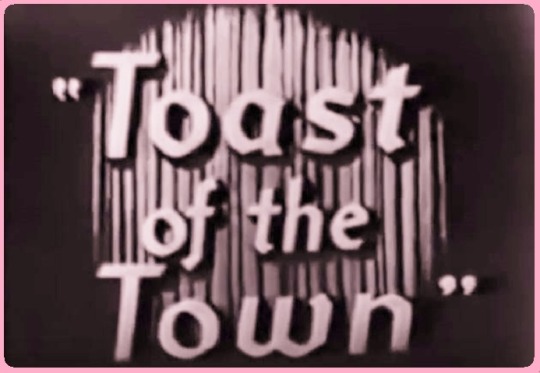
Directed by Robert Bleyer and John Moffitt
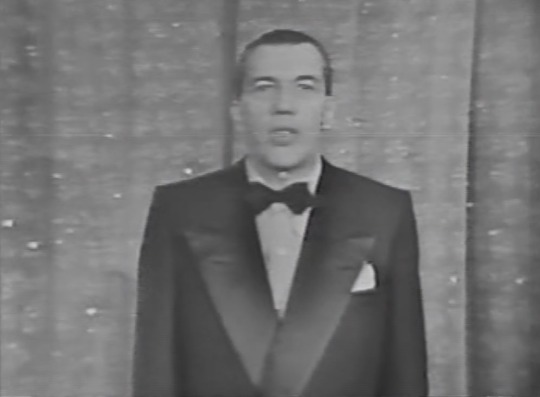
Ed Sullivan (Host) was a preeminent television variety show host who is best remembered for hosting his own show, at first titled “Toast of the Town” but later simply known as “The Ed Sullivan Show,” which became a staple of Sunday night viewing for millions of Americans from 1948 to 1971. As such, his name was often mentioned on “I Love Lucy” and Lucille Ball’s subsequent sitcoms. He introduced America to such entertainers as Elvis Presley, The Beatles, and The Supremes. Sullivan entered icon status when he and his television show were worked into the plot of the Broadway musical Bye Bye Birdie in 1960. The musical includes the song “Hymn for a Sunday Evening” which has a chorus that repeats Sullivan’s name in a choir-like harmony. Hope made an appearance in the 1964 film version. The theatre on Broadway in New York City where Sullivan did his weekly show was named after him in 1967. He died in 1974.
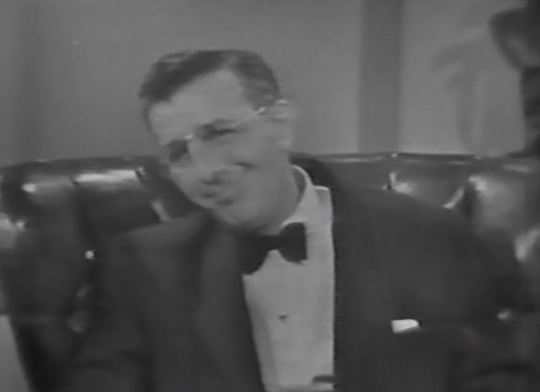
Dore Schary (Himself) was born Isadore Schary in Newark, New Jersey, in 1905. After working on Broadway he went to Hollywood were he eventually became head of MGM in 1948, ousting its founder Louis B. Mayer. He would helm the studio until 1956 and was in charge during Lucy and Desi’s filming of The Long, Long Trailer and Forever, Darling. In 1955 he was supposed to play himself on “I Love Lucy,” but backed out at the last moment and he was played by Phil Ober (Vivian Vance's husband) instead.
The MGM Stars
Lucille Ball (Herself / Tacy Collini from The Long, Long Trailer) was born on August 6, 1911 in Jamestown, New York. She began her screen career in 1933 and was known in Hollywood as ‘Queen of the B’s’ due to her many appearances in ‘B’ movies. With Richard Denning, she starred in a radio program titled “My Favorite Husband” which eventually led to the creation of “I Love Lucy,” a television situation comedy in which she co-starred with her real-life husband, Latin bandleader Desi Arnaz. The program was phenomenally successful, allowing the couple to purchase what was once RKO Studios, re-naming it Desilu. When the show ended in 1960 (in an hour-long format known as “The Lucy-Desi Comedy Hour”) so did Lucy and Desi’s marriage. In 1962, hoping to keep Desilu financially solvent, Lucy returned to the sitcom format with “The Lucy Show,” which lasted six seasons. She followed that with a similar sitcom “Here’s Lucy” co-starring with her real-life children, Lucie and Desi Jr., as well as Gale Gordon, who had joined the cast of “The Lucy Show” during season two. Before her death in 1989, Lucy made one more attempt at a sitcom with “Life With Lucy,” also with Gordon, which was not a success and was canceled after just 13 episodes.

Desi Arnaz (Himself / Nick Collini from The Long, Long Trailer) was born in Cuba in 1917 and immigrated to America as a youngster. He was a musician who married Lucille Ball in 1940 after meeting her on the set of 1939’s Too Many Girls, which he had done on stage in New York. In order to keep him ‘off the road’ Ball convinced producers to cast him as her husband in a new television project based on her radio show “My Favorite Husband.” The network was convinced. In 1951, Arnaz and Ball began playing Lucy and Ricky Ricardo, roles they would be identified with for the rest of their lives. The couple had two children together, Lucie and Desi Jr. In 1960, Ball and Arnaz divorced. Desi became a producer, responsible for such hits as “The Mothers-in-Law” (1967-69). He re-married in 1963. Desi Aranz died in 1986, just a few years before Ball.
Lucy and Desi enter to the tune of “The I Love Lucy Theme”.
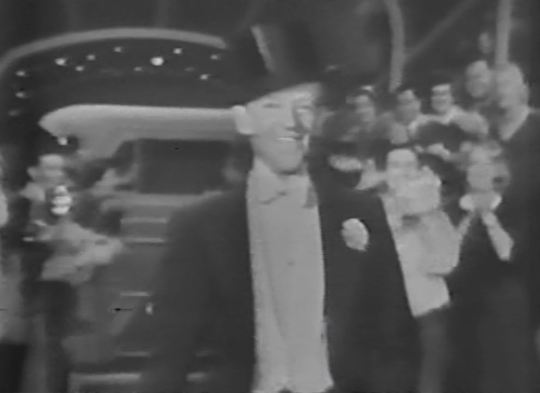
Fred Astaire (Himself / Tom Bowen from Royal Wedding / Don Hewes from Easter Parade) was one of the most famous performers in Hollywood, known for his dancing, singing, and directing. He did four films with Lucille Ball between 1935 and 1945, three with his dance partner, Ginger Rogers. Astaire received an honorary Oscar in 1950. He died in 1987 at age 88.
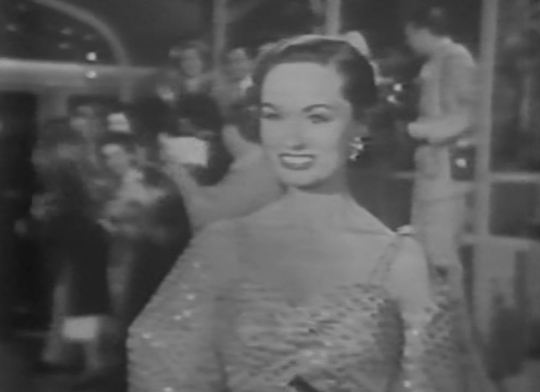
Ann Blyth (Herself / Kathie Ruder from The Student Prince) was nominated for an Oscar for her appearance in 1945's Mildred Pierce. Blyth was equally at home in musicals, a specialty of MGM.
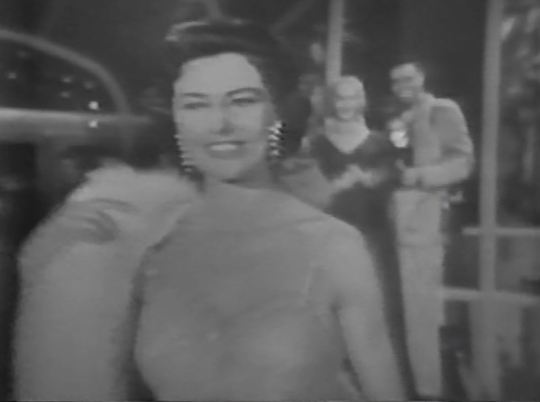
Cy Charisse (Herself) was born Tula Ellice Finklea in Amarillo, Texas. She was best known as a dancer in the MGM movie musicals of the 1950s. She did two films with Lucille Ball in the mid-1940s. She died in 2008 at age 86.
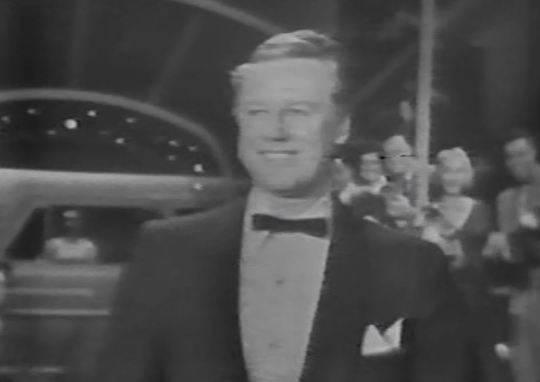
Van Johnson (Himself) co-starred in Too Many Girls (1940), the film that introduced Lucille Ball to Desi Arnaz. He was also seen with Lucy in the films Easy to Wed (1946) and the recently released Yours, Mine and Ours in 1968. He played himself on one of the most popular episodes of “I Love Lucy,” “The Dancing Star” (ILL S4;E27) as well as an episode of “The Lucy Show.” He starred in The Romance of Rosy Ridge (1947) and the 1954 film The Caine Mutiny. He died in 2008 at age 92.
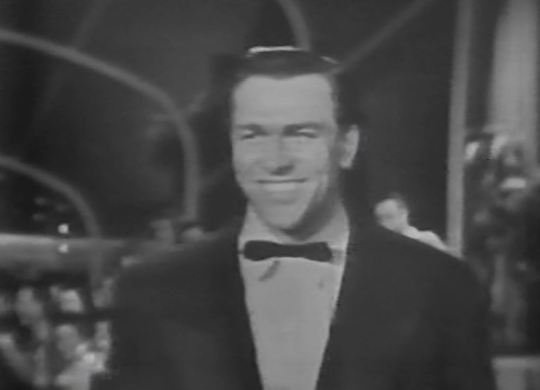
Howard Keel (Himself / Adam from Seven Brides for Seven Brothers / Frank Butler from Annie Get Your Gun) was discovered by Oscar Hammerstein II during auditions for John Raitt’s replacement in Broadway’s Carousel in 1946. After that, he also went on to play Curly in Oklahoma! He is probably best remembered for his role in MGM’s Seven Brides for Seven Brothers (1954), a film that was mentioned on “I Love Lucy.” On TV he played Clayton Farlow on “Dallas” (1981-91). His only acting appearance with Lucille Ball was on a 1969 episode of “Here's Lucy.” Keel died in 2004.
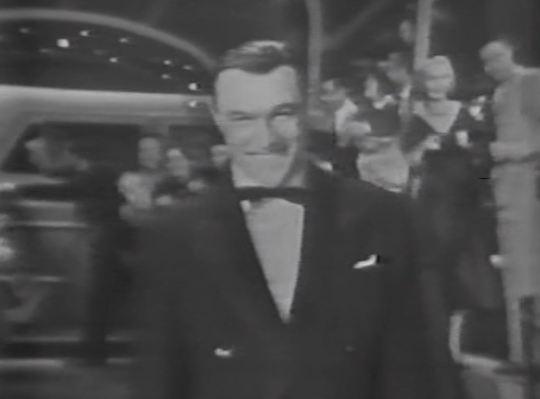
Gene Kelly (Himself / Don Lockwood from Singin' in the Rain) was an Oscar-winning performer who did four films with Lucille Ball between 1943 and 1967. In 1978 Lucille Ball was seen on the TV tribute special “Gene Kelly: An American in Pasadena.” In 1980, Kelly turned up on “Lucy Moves To NBC.” A Hollywood legend for his effortless dancing, Kelly died in 1996 at age 83.
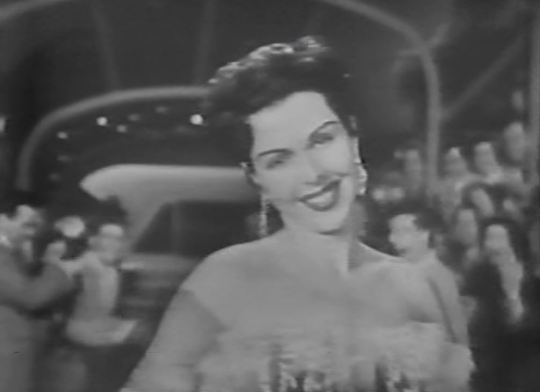
Ann Miller (Herself) was a performer best known for her singing and tap dancing in movie musicals, as well as her shapely legs. It is said that she was discovered by Lucille Ball while doing a show at a nightclub in San Francisco. She subsequently did four films with Lucille Ball, including Too Many Girls (1940), the film that introduced Lucy to Desi Arnaz. Miller died in 2004 at age 80.

Walter Pidgeon (Himself / Frederick Alderson from Executive Suite) was a Canadian-born actor who was nominated for two Oscars in 1942 and 1943. He died in 1984 at age 87.
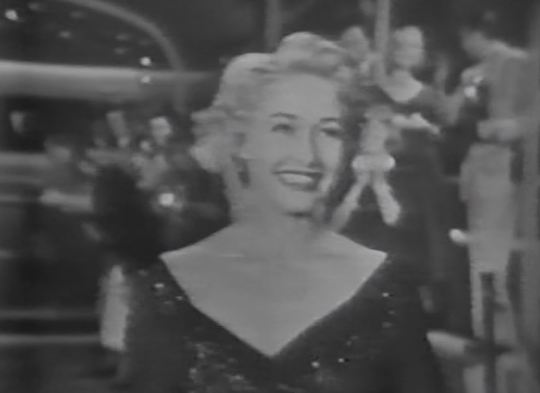
Jane Powell (Herself / Ellen Bowen from Royal Wedding) was best known for her role as Milly in Seven Brides for Seven Brothers (1954). After 1957, her film roles disappeared and Powell began performing on stage.

Debbie Reynolds (Herself) was nominated for an Oscar for playing The Unsinkable Molly Brown in 1964. Her first big hit was playing Kathy Selden in MGM's Singin' in the Rain in 1952. She died in 2016 at age 86.

Lana Turner (Herself) was one of Hollywood's most popular actresses and also a favorite of Fred Mertz. She was best known for her femme fatale roles. She was nominated for an Oscar in 1957 for Peyton Place. Turner was seen with Lucille Ball in Du Barry Was A Lady (1943). She died in 1995 at age 74.
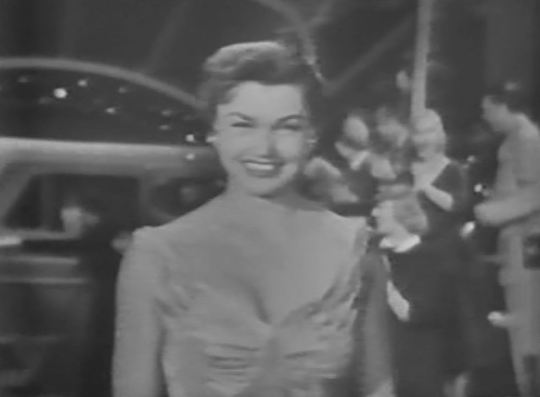
Esther Williams (Herself / Eve Barrett from Neptune's Daughter) was an actress best known for her aquatic roles. Lucille Ball starred with Williams in Easy to Wed (1946) and Ziegfeld Follies (1945). Williams was mentioned on “I Love Lucy” in 1955.
Also Appearing
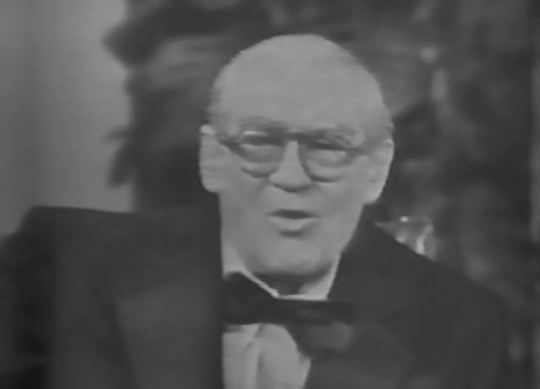
Lionel Barrymore (Himself) was the patriarch of the Barrymore acting family of stage and screen. His most famous role was that of the nefarious banker Mr. Potter in It's A Wonderful Life (1946). Barrymore had difficulty walking later in life, which accounts for the fact that he does not enter with the other MGM stars in the opening number, and why he is discovered sitting in the screening room after the first clips segment.
Edmund Purdom (Prince Karl from The Student Prince) was an English-born actor who also appeared in MGM's Julius Caesar. Purdom holds the distinction of being the only personality to have their hand/footprints removed from the forecourt of Grauman's Chinese Theater because industry insiders felt the honor was too soon, having only done three credited films. He spent his later life in Italy and died there in 2009.
Johnny Green (Himself, Conductor) was a composer and MGM's General Musical Director. He conducts the orchestra for the program.
Julia Meade (Herself, Mercury Spokeswoman) became a household name showing off dream cars of the '50s like Lincoln and Mercury bedecked in evening dresses and strings of pearls, while describing the cars with perfectly manicured hands running up and down the upholstery. She died in 2016 at age 90.
ANNIVERSARY TRIVIA

To mark their 30th anniversary, MGM also had a ten-minute orchestral overture produced for symphony orchestra comprised of themes from eleven of their great musicals. Johnny Green conducted the overture, which was filmed in Cinemascope and in color to run along with their motion pictures in cinemas.

MGM also issued a record album consisting of excerpts from the soundtracks of many of their musicals.

MGM also hosted a press event with a small number of their stars which turned up on newsreels nationwide. Louis B. Mayer and Dore Schary shook hands in front of a large cake.
TOAST OF THE TOWN
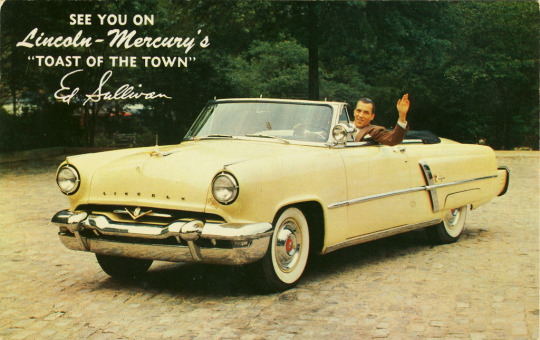
After Ed Sullivan makes some welcoming remarks, the opening number introduces the celebrities, who get out of a white limousine and walk the red carpet, greeted by fans who shout their name and the cameras of the press. These celebrities included Lucy and Desi, who are the only couple introduced and the only ones only introduced by just their first names.
Sullivan introduces MGM studio executive Dore Schary, who invites him to his private screening room. This is actually just an adjacent set on the soundstage.

One year later, Schary was to play himself on an episode of “I Love Lucy,” but withdrew at the last moment. The role was taken by Vivian Vance's husband, Phil Ober. Some said that Schary was reluctant to do television as it was supplanting MGM's film attendance, but Schary's official reason was illness. Because Ricky Ricardo (like the Arnazes) would work for MGM, it made sense to mention Schary's name early in the Hollywood episodes. Lucy's forgetful mother, Mrs. McGillicuddy (Kathryn Card), often said “Who's Dore Schary?”

In the screening room, Sullivan and Schary engage in some friendly banter (obviously read off teleprompters) in which Schary gets in a plug for MGM's upcoming film Julius Caesar directed by Joseph Mankewicz. Sullivan introduces a retrospect of MGM's first three decades, which includes a title card, and a film clip for the following movies:
THE BIG PARADE (1924) starring John Gilbert and Rene Adoree
BEN HUR (1925) starring Ramon Novarro and Francis X. Bushman
MIN AND BILL (1930) starring Wallace Beery and Marie Dressler
DINNER AT EIGHT (1933) starring Marie Dressler and Jean Harlow
MUTINY ON THE BOUNTY (1935) starring Charles Laughton and Clark Gable
SAN FRANCISCO (1936) starring Clark Gable and Jeanette MacDonald
BOYS TOWN (1938) starring Mickey Rooney and Spencer Tracy
GRAND HOTEL (1932) starring Greta Garbo and John Barrymore
A NIGHT AT THE OPERA (1935) starring Groucho Marx and Margaret Dumont
THE PHILADELPHIA STORY (1940) starring Katharine Hepburn and Cary Grant
GONE WITH THE WIND (1939) staring Clark Gable and Vivien Leigh
Sullivan adds that Gone With The Wind will be re-released in 1954. He mentions a few films that were not included in the clips: Mrs. Miniver, The Yearling, Battleground, Ivanhoe, Mogambo, Quo Vadis and Knights of the Roundtable.
Noticeable by its absence is The Wizard of Oz (1939) which (a lot like Lucille Ball herself) was only considered a classic after being seen repeatedly on television. The musical fantasy film was not aired on TV until 1956, two years after this program.
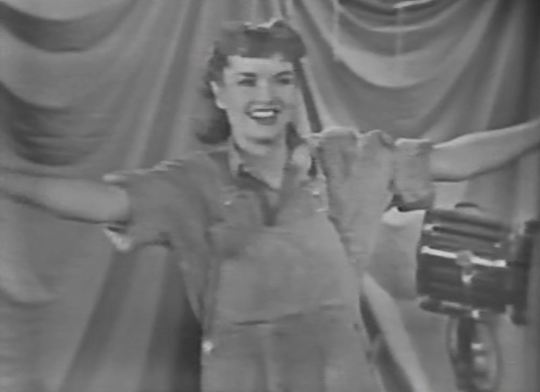
When the tribute is over, Sullivan and Schary are joined in the screening room by Lionel Barrymore, the patriarch of the fabled Drew / Barrymore acting dynasty. Barrymore introduces a young singer named Debbie Reynolds, who, dressed in overalls in a backstage setting, performs a number called “Applause, Applause” which she sang in the 1953 MGM musical Give A Girl A Break.
Blooper Alert! After the number, when Sullivan and Schary are seen in front of the curtain, the audio cuts out and only slowly returns during their conversation.
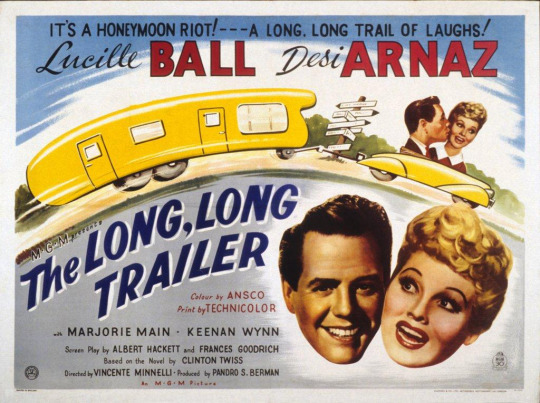
Sullivan and Schary do a live promo for their sponsor, Mercury automobiles. Schary says that Mercury cars were prominently featured in their new film The Long, Long Trailer and screens a montage of clips from the Vincente Minnelli film. Although most of the clips are of the car (which towed the title trailer), there is one classic clip of Lucy trying to make dinner in the moving trailer and one of Desi singing – both stars doing what they did best. The film premiered four days after this program aired.
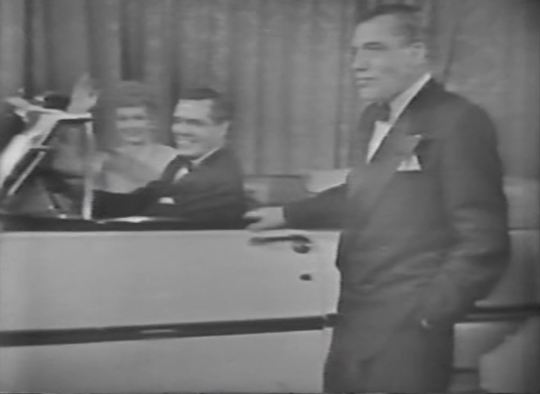
After the clips, Sullivan is standing in front of a brand new 1954 Mercury which contains Lucille Ball and Desi Arnaz in the front seat. (The car in the film was a 1953 model.) Sullivan reminds the audience that he gave Lucy and Desi the Emmy Award for “I Love Lucy” sponsored by Philip Morris. Desi has a couple of lines; Lucille merely laughs.
Blooper Alert: During the Mercury spot, Sullivan is looking into the wrong camera.
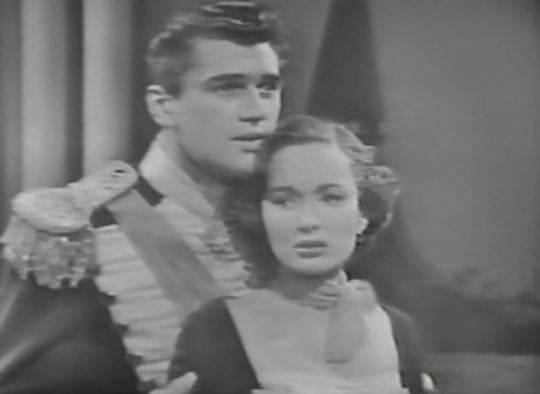
Hearing orchestral music, Sullivan approaches Dore Schary who introduces Edmund Purdom and Ann Blyth doing a live scene from their upcoming film The Student Prince, which will be released in June 1954. Because Purdom's singing voice was dubbed by Mario Lanza in the finished film, he does not sing, although Blyth performs “Deep in My Heart, Dear.”

Back in the screening room, Sullivan and Schary promote Ann Blyth's appearance in the upcoming MGM film Rosemarie. Schary presents a promo for the new film Executive Suite, which features William Holden, June Allyson, Barbara Stanwyck, Frederic March, Walter Pidgeon, Shelley Winters, Paul Douglas, Dean Jagger, and Nina Foch. Douglas, Winters, and Douglas would all guest star in “Lucy” sitcoms.

Schary introduces Howard Keel from the upcoming MGM musical Seven Brides for Seven Brothers. Stepping into a barn setting, Keel becomes Adam, his character in the film, and along with his six 'brothers' sings “Sobbin' Women.” The film opened in July 1954. In March 1956 it was mentioned on “I Love Lucy.”
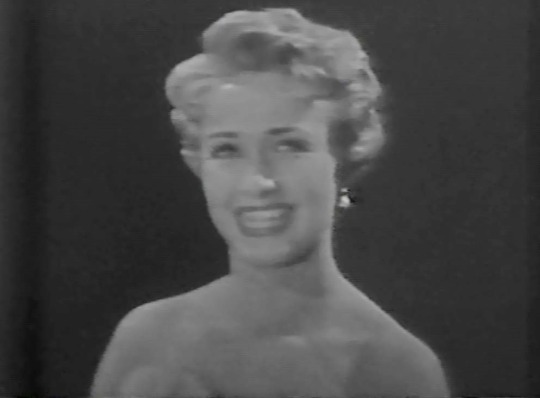
Sullivan introduces the evening's conductor Johnny Green, and Jane Powell, who sings “The Jewel Song” from the opera Faust by Charles Gounod.
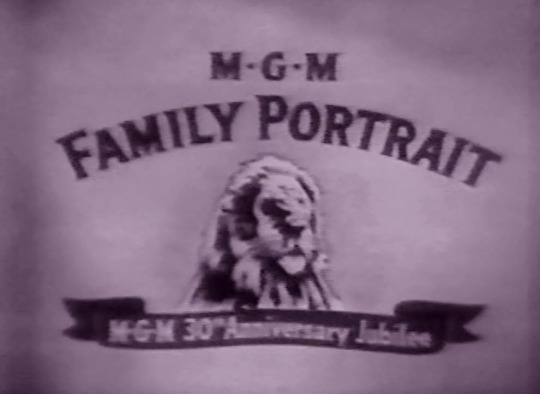
Back in the screening room, Schary introduces another round of clips, this time from famous MGM musicals:
ANNIE GET YOUR GUN (1950) starring Betty Hutton, Howard Keel, Keenan Wynn and Louis Calhern singing “There's No Business Like Show Business” by Irving Berlin
NEPTUNE'S DAUGHTER (1949) starring Esther Williams and Ricardo Montalban singing “Baby, It's Cold Outside” by Frank Loesser
SINGIN' IN THE RAIN (1952) starring Gene Kelly singing “Singin' in the Rain” by Nacio Herb Brown and Arthur Freed
ROYAL WEDDING (1951) starring Fred Astaire and Jane Powell singing “How Could You Believe Me When I Said I Loved You When You Know I've Been A Liar All My Life” by Burton Lane and Alan J. Lerner
BECAUSE YOU'RE MINE (1952) starring Mario Lanza and Doretta Morrow singing “Because You're Mine” by Nicholas Brodzsky and Sammy Cahn
EASTER PARADE (1948) starring Judy Garland and Fred Astaire singing “Easter Parade” by Irving Berlin

Back in the screening room, Ed Sullivan informs the audience that the show is coming from the brand new CBS Television City in Hollywood. Julia Meade shows the model of Television City. This is the same model shown by Jack Benny on “Stars in the Eye” the show that celebrated the new studio in 1952. It also featured Lucy and Desi. Meade turns this segment into a live commercial for Mercury.

Dore Schary introduces Lana Turner (backed up by Nick Anderson, John Erickson, Steve Forest, Edmond Purdom) who perform “A Great Lady Has an Interview,” by Roger Edens and Kay Thompson, a song sequence originally performed by Judy Garland in Ziegfeld Follies, a 1946 film that also starred Lucille Ball.
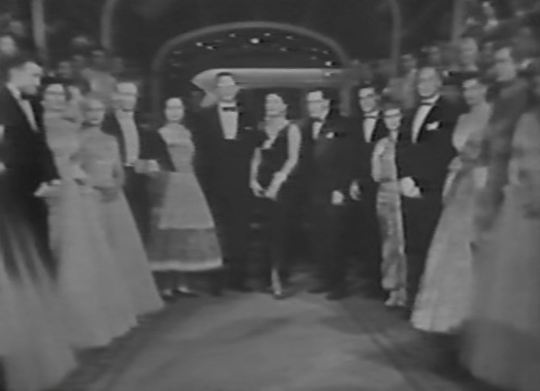
Surrounded by the MGM stars, Sullivan and Schary say goodnight.
On This Date in Lucy History ~ February 14
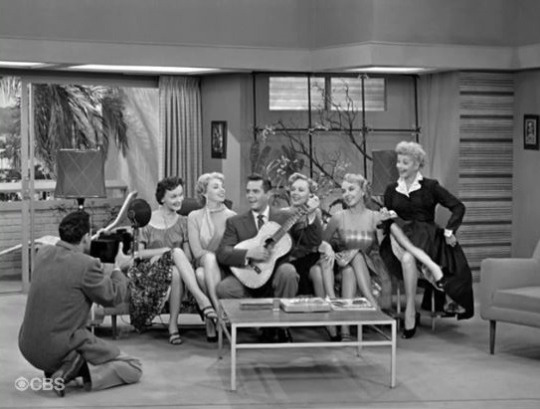
"Don Juan and the Starlets" (ILL S4;E18) ~ February 14, 1955

“Lucy Dates Dean Martin” (TLS S4;E21) ~ February 14, 1966
#MGM#Toast of the Town#The Ed Sullivan Show#Ed Sullivan#Dore Schary#Lucille Ball#Desi Arnaz#30th Anniversary#CBS#Television City#1954#TV#Lionel Barrymore#Debbie Reynolds#Fred Astaire#Lana Turner#Julia Meade#Jane Powell#Ann Blyth#Van Johnson#Ann Miller#Walter Pigeon#Howard Keel#Edmond Purdom#Esther Williams#Gene Kelly#Cyd Charisse
13 notes
·
View notes
Text
19 striking findings from 2019
19 striking findings from 2019;
Every year, Pew Research Center publishes hundreds of reports, blog posts, digital essays and other studies on a wide range of topics, from the demographic and political changes that are reshaping the United States to the attitudes and experiences of people in dozens of other countries. At the end of each year, we compile a list of some of our most noteworthy findings.
Here are 19 striking findings from our research this year:
1

Hispanics are projected to be the largest racial or ethnic minority group in the 2020 U.S. electorate, overtaking the number of black eligible voters for the first time. Hispanics are expected to account for just over 13% of eligible voters, slightly more than the share of black eligible voters.
In absolute numbers, a projected 32 million Hispanics will be eligible to vote in 2020, compared with 30 million black adults. The population of Asians eligible to vote will reach an estimated 11 million, more than double the 5 million who were eligible to vote in 2000. Asians will account for 5% of next year’s electorate. Taken together, nonwhites will account for a third of eligible voters, their largest share ever.
2The decline of Christianity is continuing at a rapid pace in the U.S. Around two-thirds of U.S. adults (65%) describe themselves as Christian, according to Pew Research Center telephone surveys conducted in 2018 and 2019. That’s down 12 percentage points since 2009. At the same time, the share of “nones” – religiously unaffiliated adults who describe their religion as atheist, agnostic or “nothing in particular” – has reached 26%, up from 17% a decade ago.

3

The U.S. no longer leads the world in admitting refugees. Canada resettled more refugees than the U.S. did in 2018, marking the first time the U.S. did not lead the world on this measure since Congress created the nation’s refugee program in 1980. While Canada resettled 28,000 refugees in 2018 – similar to its total in 2017 – the U.S. resettled 23,000, down from 33,000 the year before and far below a recent high of 97,000 in 2016. The U.S. had previously admitted more refugees each year than all other countries combined.
Looking ahead, the number of refugees resettled in the U.S. is likely to decrease further: The Trump administration set a new cap of 18,000 refugees in the 2020 fiscal year.
4

The share of Americans with an unfavorable view of China reached a 14-year high amid a protracted trade dispute between the two countries. Six-in-ten U.S. adults have a negative opinion of China, up from 47% in 2018 and the highest share since Pew Research Center began asking Americans this question in 2005.
Americans also increasingly see China as a threat. Around a quarter of Americans (24%) name China as the country or group that poses the greatest threat to the U.S. in the future, double the share who said this in 2007. China is tied with Russia (24%) as the country or group most cited by Americans as a threat to the U.S.; the only other country to measure in the double digits is North Korea (12%).
5

Three decades after the fall of the Berlin Wall, people in many former communist countries in Europe see greatly improved standards of living. Since 1991, there have been large increases in the share of adults who think the changes that swept through the region in 1989 and 1991 have had a good influence on living standards in their country. In Poland, for example, only 14% of people said in 1991 that the recent changes had had a positive influence on living standards. By 2019, that figure had shot up to 81%, more than a fivefold increase. In Lithuania, the share saying this has soared from just 9% in 1991 to 70% this year.
6The foreign-born share of the U.S. population is at its highest point since 1910. Nearly 14% of people living in the U.S. in 2017 were born in another country, extending a steady increase over the past few decades. In absolute numbers, more than 44 million immigrants lived in the U.S. – more than in any other country in the world.
The foreign-born share of the U.S. population, however, is far from the highest in the world. In 2017, 25 countries and territories had higher shares of foreign-born people than the U.S., including Australia (29%), New Zealand (23%) and Canada (21%), as well as European countries such as Switzerland (30%), Austria (19%) and Sweden (18%).

7

Majorities of U.S. military veterans – as well as the broader U.S. public – say the wars in Iraq and Afghanistan were not worth fighting. Among veterans, 64% say the war in Iraq was not worth fighting, while 58% say the same about the war in Afghanistan.
The American public holds similar views: 62% and 59% of U.S. adults, respectively, say the wars in Iraq and Afghanistan were not worth it, considering the costs and the benefits. When asked about the U.S. military campaign in Syria, 55% of veterans and 58% of the public say the campaign has not been worth it.
8A majority of Americans do not think it is possible to go about daily life without corporate and government entities collecting information about them. Americans widely believe at least some of their online and offline activities are being tracked and monitored by companies and the government. It is such a common condition of modern life, in fact, that roughly six-in-ten U.S. adults say they don’t think it is possible to go through daily life without having data collected about them by companies (62% say this) or the government (63%).

9U.S. newspaper circulation has fallen to its lowest level since at least 1940, the earliest year with available data. Total daily newspaper circulation – print and digital combined – was an estimated 28.6 million for weekday and 30.8 million for Sunday in 2018. Those numbers were down 8% and 9%, respectively, from the previous year and are now below their lowest recorded levels (though weekday circulation first passed this threshold in 2013).

10

Two-thirds of Americans support the legalization of marijuana, a dramatic reversal from two decades ago. Legalizing the drug – which remains banned under federal law – has the backing of a majority of men and women; white, black and Hispanic adults; and Democrats and Democratic-leaning independents and Republicans and Republican leaners (though Democrats remain far more likely than Republicans to favor it, 78% vs. 55%).
Meanwhile, an overwhelming majority of U.S. adults (91%) say marijuana should be legal for medical and recreational use (59%) or that it should be legal just for medical use (32%). Fewer than one-in-ten (8%) prefer to keep marijuana illegal in all circumstances.
11

The number of people living in the U.S. without authorization has decreased over the past decade, driven by a sharp decline in unauthorized immigrants from Mexico. As a result, Mexicans no longer account for the majority of unauthorized immigrants in the country. In 2007, there were 12.2 million unauthorized immigrants in the U.S., including 6.9 million Mexicans. By 2017, there were 10.5 million unauthorized immigrants, including 4.9 million Mexicans.
While the number of unauthorized immigrants from Mexico has decreased, the numbers from two regions – Asia and Central America – have risen. Overall, there were 5.5 million unauthorized immigrants from countries other than Mexico in 2017, compared with 5.3 million in 2007.
One reflection of the changing migration patterns is at the U.S.-Mexico border, where apprehensions of non-Mexican migrants vastly outnumbered those of Mexicans in the 2019 fiscal year (80% vs. 20%). In 2000, by comparison, non-Mexicans accounted for just 2% of apprehensions at the southwest border, while Mexicans accounted for 98%.
12

Roughly six-in-ten Americans (63%) say the legacy of slavery still affects black people in the U.S. today. This is particularly the case for black Americans, 84% of whom say the legacy of slavery affects the position of black people in the U.S. today either a great deal (59%) or a fair amount (25%).
By comparison, 26% of whites, 29% of Hispanics and 33% of Asians say the legacy of slavery affects the position of black people in American society a great deal, though majorities in each group say it does so at least a fair amount. This year marked the 400th anniversary of the arrival of the first slave ship in Jamestown, Virginia.
13Political independents who don’t lean toward one party or the other account for only 7% of Americans. While they are often portrayed as political free agents with the potential to bridge the nation’s rigid partisan divisions, most independents are not all that “independent” politically. An overwhelming majority of independents (81%) “lean” toward either the Republican Party or the Democratic Party. And the small share of Americans who don’t lean toward either party stand out for their low level of interest in politics.

14

Despite the economic troubles facing the news industry, about seven-in-ten Americans (71%) believe their local news media organizations are doing well financially. This belief persists even though only 14% of U.S. adults say they personally have paid for local news within the past year, whether through subscriptions, donations or memberships. When asked why they don’t pay for local news, around half of non-payers (49%) point to the widespread availability of free content.
15

The most active 10% of adult Twitter users in the U.S. produce 80% of all tweets sent by these users. The median adult user of the platform tweets just twice a month, but a small group tweets much more frequently, according to our April study. There was an even starker pattern in a follow-up study that looked specifically at tweets about national politics. In that study, 97% of tweets that were created by U.S. adults and mentioned national politics came from just 10% of users.
16

Roughly a third of Gen Zers (35%) say they know someone who prefers to be referred to using gender-neutral pronouns. Gen Zers (Americans born after 1996) are more likely than Millennials (born between 1981 and 1996) to say they know someone who prefers this: 35% say this is the case, compared with a quarter of Millennials and smaller shares in older generations.
The youngest generation is also the most likely to say that forms or online profiles that ask about a person’s gender should include options other than “man” or “woman.” Roughly six-in-ten Gen Zers (59%) hold this view, compared with half of Millennials and four-in-ten or fewer Gen Xers (born 1965 to 1980), Baby Boomers (1946 to 1964) and members of the Silent Generation (born 1928 to 1945).
17The U.S. public renders a harsh judgment on the state of political discourse in the country today. Large majorities of Americans say the tone and nature of political debate has become more negative in recent years, as well as less respectful, less fact-based and less substantive. President Donald Trump is a major factor in people’s views: A 55% majority says Trump has changed the tone and nature of political debate in the country for the worse. Fewer than half as many (24%) say he has changed it for the better, while 20% say he has had little impact.

18

Concerns about climate change have risen in the U.S., but most of the change has come among Democrats. The share of Americans who see global climate change as a major threat to the well-being of the U.S. has increased from 40% in 2013 to 57% this year, but Republican attitudes about this have changed little. Around a quarter of Republicans and Republican-leaning independents (27%) now say climate change is a major threat, about the same as the 22% who said this in 2013. Among Democrats and Democratic leaners, by contrast, 84% say global climate change is a major threat, up from 58% in 2013.
Nearly all liberal Democrats (94%) consider climate change a major threat to the nation, up 30 percentage points from 2013. Three-quarters of moderate and conservative Democrats also say this, up from 54% in 2013. By contrast, there has been no statistically significant change among either moderate or conservative Republicans.
19A single person watching YouTube videos for eight hours a day with no breaks or days off would need more than 16 years to watch all the content posted by just the most popular channels on the platform during a single week. These popular channels – defined as those with at least 250,000 subscribers – posted nearly a quarter-million videos in the first seven days of 2019, totaling 48,486 hours of content. The average video on these channels was roughly 12 minutes long and received 58,358 views during its first week on the site. Altogether, these videos were viewed over 14.2 billion times in their first seven days.

Read the other posts in our striking findings series:
; Blog – Pew Research Center; https://www.pewresearch.org/fact-tank/2019/12/13/19-striking-findings-from-2019/; ; December 13, 2019 at 01:17PM
0 notes
Photo

Available for wholesale 💃💃 Cubic Zircon jewelry sets on stock for orders ping me WhatsApp +91 9884422969 or DM for pricing . Immediate shipping 💃💃 #pinkyexporterindia #naijajewelrystore #naijajewelrywholesaler #lagosweddings #abujaweddings #kanowedding #abujajewelryseller #lagosbrand #cubiczirconjewelry #northernwedding #melaninpoppin #jewelleryaddict #czjewelry #noscamming #pinky_exporter #nigerianwedding #partyqueen#weddingguest #igbobride#naijawedding #fashionqueen #partyguest#luxuryjewelry #lovejewelry#jewelryblog #jewelrygram #Dnocodejewelry #owanbeuk #bridalstore (at Jamestown, Rhode Island) https://www.instagram.com/p/B3ov-vYFAP6/?igshid=bqcuzwo3c3rm
#pinkyexporterindia#naijajewelrystore#naijajewelrywholesaler#lagosweddings#abujaweddings#kanowedding#abujajewelryseller#lagosbrand#cubiczirconjewelry#northernwedding#melaninpoppin#jewelleryaddict#czjewelry#noscamming#pinky_exporter#nigerianwedding#partyqueen#weddingguest#igbobride#naijawedding#fashionqueen#partyguest#luxuryjewelry#lovejewelry#jewelryblog#jewelrygram#dnocodejewelry#owanbeuk#bridalstore
0 notes
Photo

Our Analysis
There is a 35% chance that Donald Trump wrote this tweet himself.
This is tweet number 1135 mentioning the Democrats from @realdonaldtrump -- 974 since inauguration.
Word probabilities: 8/91 (Trump/Staff) Time probabilities: 26/73 (Trump/Staff) Metadata probabilities: 54/45 (Trump/Staff) Posted at: Tue Jul 30 12:23:19 2019 EDT [Link] Tweet Source: Twitter for iPhone
The most informative terms in this tweet were: great (Trump, 1.4:1), reception (Trump, 1.4:1), & (Other, 2.3:1), democrats (Trump, 4.0:1), respect (Trump, 4.2:1), country (Trump, 2.1:1), incredible (Other, 1.5:1), heritage (Trump, 1.4:1), thank (Other, 3.9:1), ! (Trump, 1.3:1)
A computer sees the following emotions in this tweet (NRC): {'trust': 2, 'joy': 1, 'anticipation': 1, 'positive': 1}
Grade level of this tweet (Flesch-Kincaid): 8.8
Great reception in Jamestown by both REPUBLICANS & DEMOCRATS. Respect for our Country’s incredible Heritage. Thank you!
-Some random staffer (possibly Dan Scavino), on behalf of President Donald J. Trump
#trump#donald trump#tweet#twitter#donald j trump#president#tweet analysis#trump tweet analysis#dems#democrats#democrat#dnc#@dnc#great#reception#jamestown#republicans#respect#incredible#heritage#thank
0 notes
Text
World Famous Astrologer in New York

Ex-love back by Vashikaran Guru
Pandit Kapil Sharma Expert in Vashikaran and Sifli ilm, Horoscopes, Astrology, Black Magic, Mantras, Evil Spells, the intentional use of negative powers to affect in Horoscope, and Wish-fulfillment Pujas Havan vashikaran hypnotism and other problems. It can bring new peace, prosperity happiness in your life and get your love back. Pandit Kapil Sharma is a very good astrologer & world gold medalist. Pandit Kapil Sharma solved all type problem through hand line, Kundli, palm, photo etc. pandit ji solved all hard to hard problem in life example as education, business loss, husband wife relationship, court case, love marriage, vashikaran on boyfriend, vashikaran on your life partner, lost her/his love, to get your love back, money problem, tour travel, job, wife vashikaran etc. there are several aghori who claim to get your love back by vashikaran mantra, but most of the time their mantra never work, pandit ji provide love back by vashikaran mantra with full guarantee, that you will 100% get your love back within couple of days, love back by vashikaran mantra is not so easy and the spell should be executed properly and that why with the expertise of babji can caste the love back by vashikaran spell with full guarantee that it will work and you will get your love back.get my love back by Vashikaran.
Call now without hesitant +91 8875270809, 7891464004.
Whatsapp No. +91 8875270809
· Pandit Kapil Sharma a Famous Astrologer in New York.
· Pandit Kapil Sharma solved more than 7500+cases.
· Pandit Kapil Sharma Specialist in Vashikaran & Black magic
· Pandit Kapil Sharma Belong From Rajasthan.
· Pandit Kapil Sharma certified in Astrology services.
· Pandit Kapil Sharma has more than 30-years experience.
· Pandit Kapil Sharma’s family is Provide Astrology services to all since last 98 years.
Pandit Kapil Sharma provides Astrology services in these areas.
Albany, Binghamton, Buffalo, Elmira, Ithaca, Jamestown, Long Beach, Mount Vernon, New Rochelle, Niagara Falls, Poughkeepsie, Rochester, Rome, Schenectady, Syracuse, Troy, Utica, White Plains, Yonkers
0 notes
Text
Because It's Time (For All Mankind ep 2.3 "Rules of Engagement" missing scene fic)
This is a "missing scene" that takes place in 2.3 "Rules of Engagement" after Ed has been confronted by Tracy about Gordo returning to the moon.
Gordo and Ed talk about Gordo's impending return to Jamestown and how his training is going.
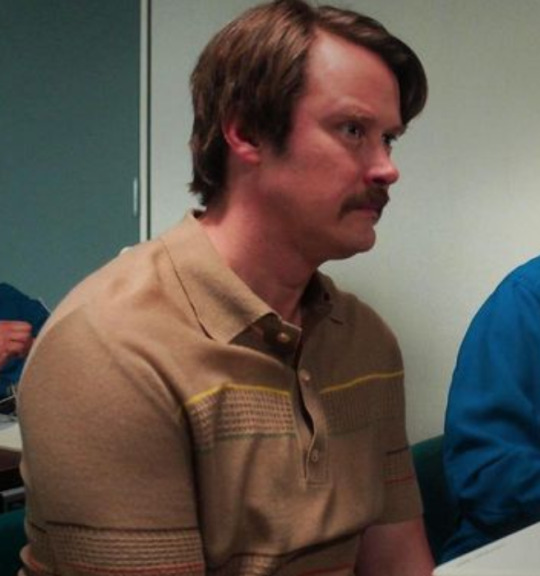
Because It's Time (1095 words) by GordoPickett Chapters: 1/1 Fandom: For All Mankind (TV 2019) Rating: General Audiences Warnings: No Archive Warnings Apply Characters: Gordo Stevens, Ed Baldwin, Tracy Stevens (mentioned), Danielle Poole (mentioned) Additional Tags: Episode: s02e03 Rules of Engagement (For All Mankind), Missing Scene, Deleted Scene, Gordo's weight gain, Chubby Gordo, Chubby Gordo Stevens, chubby teddy bear Gordo Stevens, El Gordo, Insecurity, For All Mankind missing scene, For All Mankind deleted scene, Jamestown 91, NASA, Astronaut Series: Part 4 of For All Mankind Summary: This is a "missing scene" that takes place in 2.3 "Rules of Engagement" after Ed has been confronted by Tracy about Gordo returning to the moon. Gordo and Ed talk about Gordo's impending return to Jamestown and how his training is going.
#for all mankind#gordo stevens#ed baldwin#danielle poole#tracy stevens#fanfic#fam#michael dorman#gordostevens#edbaldwin#forallmankind#missing scene#deleted scene#for all mankind fic#for all mankind fanfic#for all mankind fic missing scene#weight gain#NASA#Jamestown 91#chubby Gordo Stevens#chubby teddy bear Gordo Stevens#chubby Gordo#ao3#ao3 fanfic#ao3 fic#because it's time#gordopickett fic#gordopickett writing#gordopickett
0 notes
Text
notes on "islands of the mind" by john gillis (ch. 5)
Ch. 5: "Islands in the Making of Atlantic Civilization"
83: "To grasp what this lost Atlantic civilization was like we might want to recall precolonial Polynesia, a Pacific civilization where the inhabitants saw themselves as living in a sea of islands, connected rather than divided by water, a kind of aqueous continent that stretched for thousands of miles in many directions. "Their universe comprised not only land surfaces, but the surrounding ocean as far as they could traverse and exploit it," write Epile Hau'ofa. Though Westerners think of islands as small places, to the Polynesians their island world "was anything but tiny." (reference here to "Our Sea of Islands" by Epile Hau'ofa in The Contemporary Pacific: A Journal of Island Affairs, spring 1994) To them, the sea was home, a place rather than an interval between places. Connected to the sea around them, islands were not perceived as either remote or insular."
85: for Europe 1500-1800: "Islands were not only the lands that Europe principally explored, claimed, and colonized, but those it imagined and fictionalized."
86: "After all, the notion of the world mapped onto clearly bounded territories is a very modern notion. The Middle Ages, as Michael Biggs notes, was "essentially a mapless world" known as a "succession of places." (reference here to "Putting the State on the Map" by Michael Biggs, in Comparative Studies in Society and History, 1999) Distance was calculated in terms of the time it took to travel from place to place rather than in precise measures of space. States were not centralized or unified as tightly bounded territories. Sovereigns reigned over a scatter of lands, often far distant from one another, more like an archipelago than a continent. This condition continued throughout the early modern period, and it was only in the nineteenth century that contiguity of territory became the mark of a developed nation-state. Until then, archipelagos of territory, whether landlocked or sea-girt, were just as attractive to sovereigns as more unified and centralized lands."
87: "The Black Death a century earlier had solved the overpopulation problem, making it very difficult to get people to settle the New World. Those first to cross the Atlantic were looking for a quick return on their investment and an equally quick return home. During the sixteenth century it was gold and silver that lured men offshore. And even those who came to settle did not want to work the land." (reference here to epilogue by Robert S. Lopez in First Images of America: The Impact of the New World on the Old, vol 2, ed. Fredi Chiapelli, 1976)
"The Spanish were lured inland by gold and silver, but their settlements were in many ways exceptional. The French and English launched similar searches for treasure, but when these proved unsuccessful they had to settle for fish and furs. These enterprises did not involve permanent settlement until the seventeenth century, however, and when that finally happened it was on islands, not mainlands. Fishing required no continental connection at all, while the fur trade was in the hands of Native americans, making inland settlement irrelevent. Fishermen had set a precedent for the use of islands early on by camping there in the summer months. Newfoundland and islands along the New England coast served this purpose well in the sixteenth century, but never led to permanent populations. Islands had the advantage of being Accessible to the mainlands, but also fortifiable against the Native Americans onshore."
87-88: "Sable Island, a whaling station off Nova Scotia founded by the Marquis de la Rock, became the first French colony to last more than a year. But its colonists were minor criminals rounded up for the purpose of labor, and in 1603 they turned on their guards and escaped their island prison, thus ending the enterprise. The English also looked to islands, first to Roanoke and then Jamestown, for their first permanent settlements. But the colony on Roanoke Island was a failure, and Jamestown came close to disaster because of disease and the aristocratic colonists' lack of skills and deficient work habits. It was only when a suitable export crop, tobacco, proved profitable that the inland dimension of the Virginia experiment was assured."
88: "Just how insular Europe's designs on the New World continued to be is illustrated by the fact that in the eighteenth century islands were still seen as more valuable than mainlands. While the Spanish tended to withdraw to the mainlands, other European power competed tenaciously for the vacated isled. Even tiny islands were coveted and fought over far more than large territories. St. Luca changed hands so many times--fourteen--that today it is a French/English hybrid. The population speaks a French patois but drives like the English on the left side of the road. In the treaty negotiations with the British in 1763 that ended the Seven Years War, the French were more interested in holding onto the tiny sugar-producing island of Gaudeloupe than in keeping the vast territories of Canada. Ambivalent attitudes toward mainlands would persist right up to the nineteenth century."
"Islands had always been of strategic advantage to Europeans. Beginning with the Crusades, the islands of the Mediterranean had been their stepping-stones. As Fernand Braudel described it, Europeans moved "crab-wise from rock to rock," rarely going far inland. (reference here to epilogue by Robert S. Lopez in First Images of America: The Impact of the New World on the Old, vol 2, ed. Fredi Chiapelli, 1976) Many eastern Mediterranean isles remained under their indirect control until the fifteenth century, when the Venetians had important colonies on Crete, Corfu, and numerous other islands. The Venetian intention was not control of territory but control of trade, and they became the envy of and the model for their neighbors. It was on islands that they developed immensely valuable sugar plantations. Sugar production began in Syria and Palestine, but, when control of these areas was lost in the fourteenth century, the technique was moved to Cyprus, and then to Crete and Sicily. There it became associated with slavery, so that when in the fifteenth century the Genoese took sugar production to the Canaries and the Madeiras they imported Africans as the newest slave supply. columbus introduced sugar in San Dominique in 1493. From there sugar and slavery spread in tandem throughout the Caribbean."
90: "When European interest turned to the extraction of resources, islands offered some of the most lucrative opportunities. Beginning with the Azores and Madeiras, islands were first areas to be stripped of their native timber, animal and plant populations. The next step was the importation of European herds and crops, altering forever the ecology of those places. The production of sugar using slave labor, already perfect on Mediterranean isles, was first transferred to the near Atlantic islands and then to the Caribbean. And islands were to remain the preferred locations for plantation economies for almost three hundred years."
"These are best defined as empires of access, not empires of possession. The interiors of the Asian, African, and American continents were neither known nor coveted until the nineteenth century. What was desired was access to the goods (including slaves) that were produced on the continents, not the continents themselves. This was best achieved by control over coasts and coastal islands."
"Europeans were content to let the peoples of the interior, whether they be African slavers or Native American fur traders, control their end of the business. Indeed, they preferred it that way."
91: "The empire of access was empire on the cheap. Even the strongest Renaissance kingdoms were weak and poor by world standards."
"Borders mattered much less in polities where allegiances were organized hierarchically rather than horizontally, where sovereignty was attached to persons rather than to territories. In a world of vertical rather than horizontal perspectives, Europeans at every level were willing to accept authority from "above," even when this power was from the "outside." Loyalties to foreign rulers, which would be quite unacceptable in the modern territorial state, were routinely accepted until the nineteenth century, when the rise of the nation-state finally severed sovereignty from individuals and vested it in clearly defined lands and people."
"Early modern kingdoms did not possess the kinds of standing armies necessary to control territory outside their own domains and certainly not that overseas. They were used to wielding power at a distance, handing out islands as feudal fiefs and concessions rather than ruling them directly. Anthony Pagden has described the most powerful empire within Europe, that of Charles V, as being more like "a modern multinational corporation than a state." (reference here to "Afterword: From Identity to Independence" by Anthony Pagden and Nicholas Canny in Colonial Identity in the Atlantic World, 1500-1800, eds. Anthony Pagden and Nicholas Canny, 1987) Crowns did not yet possess a monopoly on armed force and continued to rely on private individuals and groups as extensions of sovereign power. Granting charters, fiefs, and special powers was the way in which European expansion had proceeded in the later Middle Ages, and this would continue to be the practice up through the eighteenth century. The Portuguese found they could keep Madeira going only by encouraging the settlement of Flemings. To achieve their goals, kings readily indulged the "insular romanticism" of the nobility, freely handing out fiefdoms on islands that were only presumed to exist. Columbus may have thought he would be rewarded with Antilia, which he fully expected would be one of the stepping-stones to India. Monarchs could afford this generosity because the supply of unclaimed isles seemed inexhaustible. It was a cheap and easy way of extending patronage; and Columbus was only one of many islomanes to be encouraged by such a strategy, which worked well as long as the reality of the Atlantic isles was still obscured by the legends conjured up by enduring insular romanticism."
92: "Merchants invested in inventory, not directly in production." "Urban merchants warehoused both raw materials and finished products in what were called at the time "factories," but they preferred to keep actual production t a distance, like islands in the far sea."
"The merchant capitalists operated from within urban enclaves in their homelands or abroad under charters issued by foreign rulers. Commercial capitalism functioned extremely well in this archipelagic environment." "Profits were made by attempting to calculate when to release or withhold inventory, or by controlling markets according to mercantilist principles."
92-93: "Islands were particulrly significant in the Atlantic slave trade. Access to sources of slaves required no possession of territory, something that was in any case beyond the power of Europeans to achieve against the overwhelming strength of inland African kingdoms and the deadly effects of tropicl diseases." "Places like Goree and Bance Islands were used to hold and "season" human inventories, natural prisons in this era of forced labor. One of the most successful of these operations was in Cape Verde Islands, whose slave markets had the reputation of being pricey but delivering value for money. Bentley Duncan writes that its slaves were considered a better buy because "the most unfit, the most sickly...had already been culled." Cape Verde slaves had "endured the trauma of their first sea passage, their bonds with the mainland were already loosened; their incentive for escape was weakened, and the opportunity to do so much diminished." (reference here to Expansion and Global Interaction, 1200-1700 by David Ringrose)
93-94: "Europeans had their sugar islands in the Mediterranean since the Middle Ages, but the favored location in the seventeenth century became the islands of the Caribbean, where the soils and climate proved right for the crop and the geography crucial to the control of the largely slave labor force. As long as Europeans controlled the waterways, islands' extensive coastline guaranteed them access while denying their captives exit. The same thinking applied to places where white convict labor was imported. It is no wonder that some of the first permanent colonies, staffed with prisoners, were islands. The greater the proportion of coast to interior the better, for smaller islands like Barbados had no hinterlands to escape to. But even larger islands like Jamaica were preferable to the mainlands, and so began the long and tragic association of islands with imprisonment, something that still exists today."
0 notes